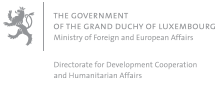- Home
- Preface
- I. Luxembourg’s official development assistance in 2014
- 2015 – European Year for Development
- Multilateral cooperation commitments in the health sector
- Action plan for development effectiveness 2014-2016
- II. Cooperation with the main partner countries
- III. Regional cooperation and cooperation with other countries
- IV. Multilateral cooperation
- V. European Union
- VI. Cooperation with non-governmental development organisations
- VII. Humanitarian action
- VIII. Programme support
- IX. Development education and awareness raising
- X. Microfinance
- XI. Evaluation
- XII. Report on the progress of the work of the Interministerial Committee for Development Cooperation
- Appendices
Multilateral cooperation commitments in the health sector

UNAIDS
In 2014, Luxembourg was the Board member on the UNAIDS Programme Coordinating Board (PCB), representing its constituency, which includes Belgium, the Netherlands and Portugal. Luxembourg coordinated the positions of the four constituency members on the various topics on the agenda of the two PCB meetings held in 2014, from 1-3 July and 9-11 December. The positions taken by Luxembourg while on the Board have managed to influence a number of decisions taken, especially regarding the role of HIV/AIDS in the post-2015 development agenda, as well as regarding paediatric treatment and social protection. The decisions of the 34th PCB (July 2014) on the post-2015 agenda item have been communicated officially by the Chair (Australia) and the Vice-Chair (Zimbabwe) of the PCB to the President of the General Assembly of the United Nations, to the Secretary-General, as well as to the Chair and Vice-Chair of the Open Working Group on the Sustainable Development Goals. At the end of the year, Luxembourg handed over the Board seat to the Netherlands to represent our constituency.
In October 2014, the annual bilateral consultations with UNAIDS took place to take stock of the relations between Luxembourg and the Joint Programme. The consultations were chaired by UNAIDS’ Executive Director, Michel Sidibé, and the results were very positive on both sides. Luxembourg is not simply regarded as a reliable, long-term donor but also as a strong political ally supporting UNAIDS on issues that are sometimes very sensitive, thus contributing the required influence and political weight to push them forward. It was also during these consultations that UNAIDS invited Luxembourg to become the champion of its new “90-90-90” treatment target, an invitation which Luxembourg accepted with pleasure.
“90-90-90” follows on from “Treatment 2015”, which aimed to provide treatment for 15 million people infected with HIV by December 2015; this objective will be achieved or even exceeded by the spring of 2015. “90-90-90” goes much further, specifying that, by 2020, 90% of persons living with HIV will know their HIV status, 90% of persons diagnosed with HIV will receive sustained antiretroviral therapy and 90% of persons receiving antiretroviral therapy will have viral suppression. For the first time, these objectives apply to the entire population – adults, children, key populations, etc. Even though “90-90-90” is a treatment target at its core, it includes some key aspects of prevention and a comprehensive combination prevention approach is essential to fight the epidemic.

